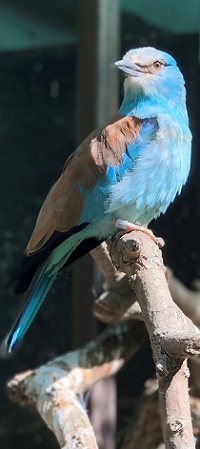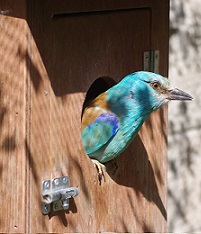European Roller
Coracius garrulus
- Habitat: Temperate, steppe and Mediterranean regions
- Range: Europe, Morocco, Central Asia and Middle East
- Natural Diet: Insects and spiders
- Status in the Wild: Common
All about the European Roller
European Rollers are closely related to kingfishers and bee-eaters. These birds are very colorful with their plumage being bright blue with black beaks. They have featherless black patches around their eyes. Their tail feathers have a diversity of colors that include midnight blue, dark and light blues with the tips being white and black. Their backs a covered with brownish-orange colored feathers with midnight blue closer to the tail end. Their wings also have an assortment of colors from midnight blue, dark, and light blues with the tips being white below the wings and black on top of the wings. Males and females are of the same color, shape, size, and form (monomorphous). These rollers are around a foot in body length with a two-foot wingspan. They are very light in weight weighing less than half a pound.
Diet/ Habitat/ Range
European Rollers have a very wide distributional range covering most of Europe, western Asia, and Africa. They are habitat generalists living in a diversity of habitats that include grassland, savanna, forest, and urban/ agricultural areas. They mainly feed on insects and other invertebrates, amphibians, reptiles, and small birds.
Behavior
European Rollers migrate extensively for long distances from their breeding grounds in Europe and western Asia to their wintering grounds in Africa. Their vocalizations are loud and shrill when they are alerting their family that predators are close by (alarm call).
Reproduction
European Rollers breed once a year. They are monogamous with the females selecting single male partners that they pair and breed with for life. These birds nest in tree hollows, stumps, and cavities. Females lay one to seven eggs each breeding season. Both males and females incubate eggs and feed their chicks (biparental care). While females predominantly incubate eggs and feed their chicks, the males defend their territories protecting their partners and chicks from predators and competition. Chicks fledge when they are a month old. Chicks are known to vomit a foul-smelling fluid that deters predators.
Conservation/Status
Although they have been categorized as Least Concern by the International Union for World Conservation, there is a decreasing trend in the population growth of wild European Rollers due to hunting, pesticide use, and habitat destruction due to habitat conversion to agricultural pastures.


